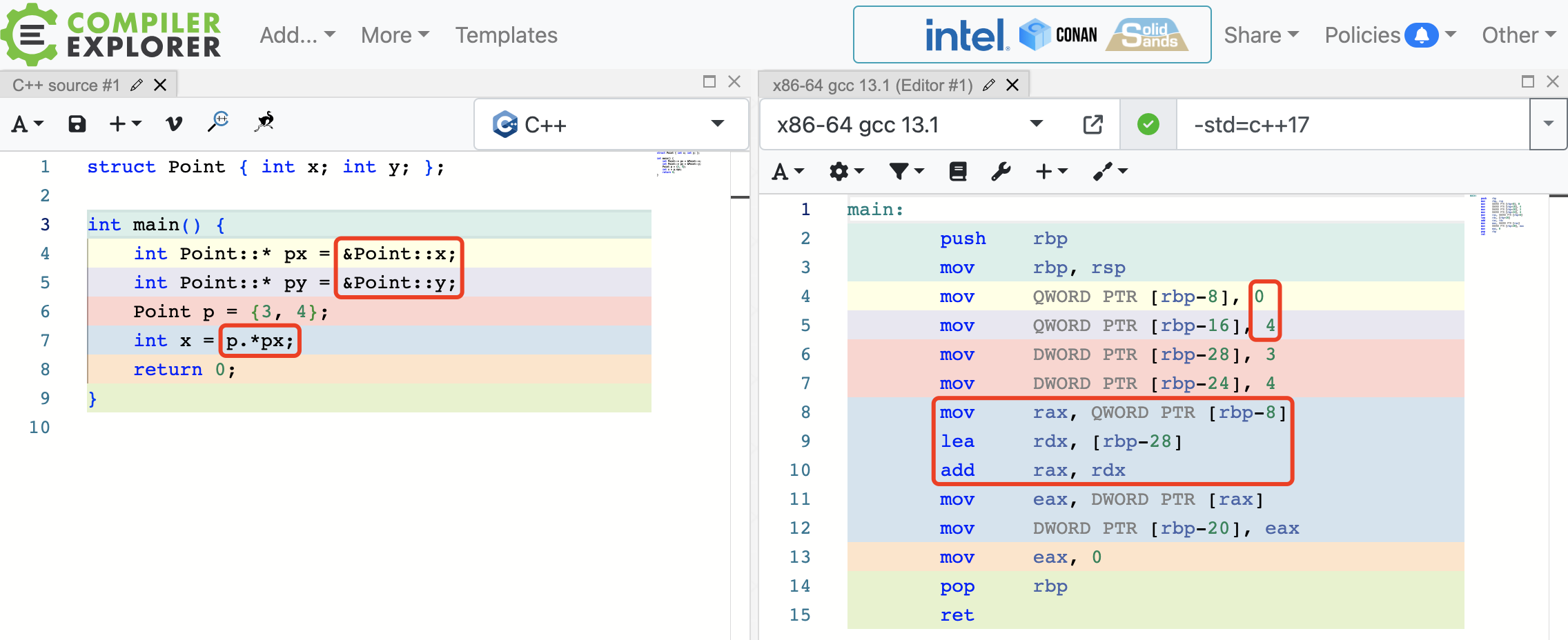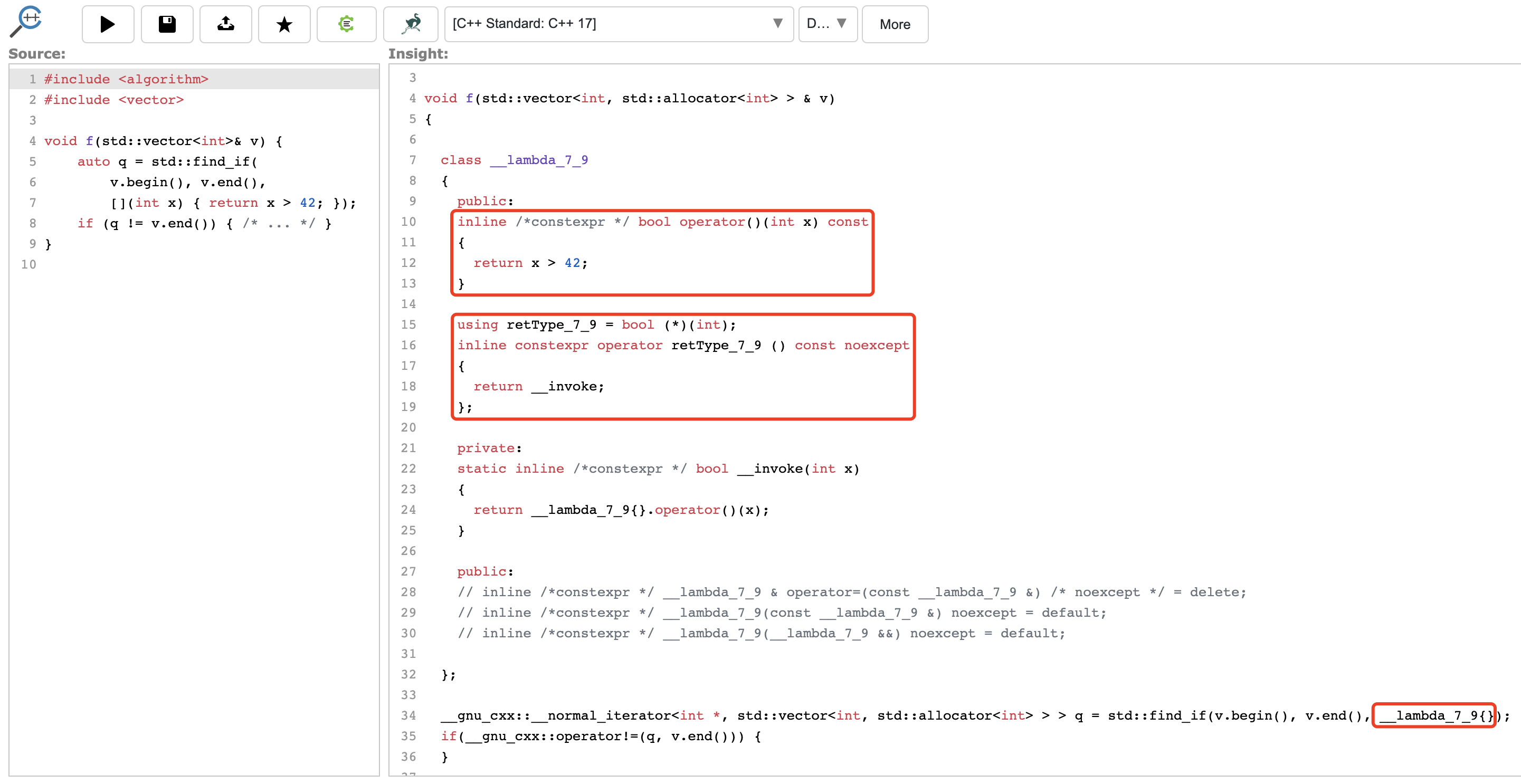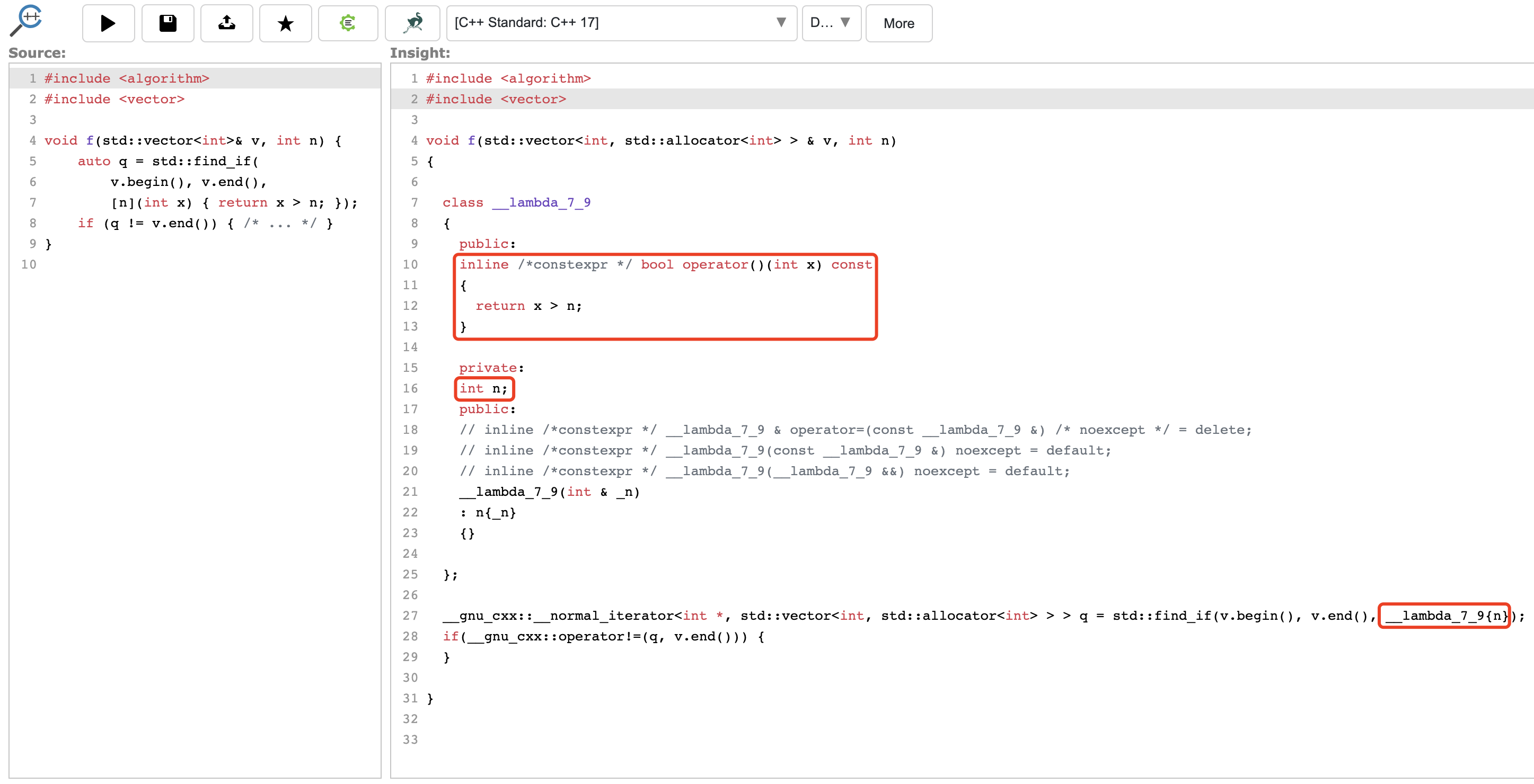C++函数式编程
1.引言
函数式编程(functional programming)是一种编程范式,通过函数的求值和组合来构造程序。在函数式编程中,函数被视为一等公民,可以像其他数据类型一样作为参数传递和从函数中返回。接受函数作为参数、或者返回函数的函数叫做高阶函数(high-order function),是函数式编程的核心概念之一。函数式编程强调使用纯函数(pure function),即没有状态和副作用、返回值只依赖于参数的函数。
例如,在Scala中计算一个数组中所有偶数的平方和,使用传统的命令式编程(imperative programming):
1
2
3
4
5
6
var result = 0
for (x <- arr) {
if (x % 2 == 0) {
result += x * x
}
}
使用函数式编程:
1
2
3
val result = arr.filter(x => x % 2 == 0)
.map(x => x * x)
.reduce((x, y) => x + y)
其中,filter()、map()和reduce()是高阶函数,x => x % 2 == 0、x => x * x和(x, y) => x + y是纯函数。
函数式编程提供了一种清晰的、模块化和可扩展的编程方式,在并发和大规模数据处理等领域具有优势。C++11、Java 8、Python、Scala等编程语言都提供了支持函数式编程的特性。
本文将介绍C++中支持函数式编程的语言特性,包括函数对象、函数指针、Lambda表达式等。
2.函数对象
函数对象(function object)是指重载了函数调用运算符(function call operator) operator()的对象,从而能够像函数一样被调用。例如函数指针、Lambda表达式、std::function对象,以及任何重载了operator()的自定义类型的对象。函数调用运算符的参数列表和返回值可以是任意的。
例如,Linear对象表示一次函数 $y = ax + b$:
1
2
3
4
5
6
7
8
9
10
11
12
13
14
15
// An object of this type represents a linear function y = a * x + b.
struct Linear {
double a, b;
double operator()(double x) const { return a * x + b; }
};
int main() {
Linear f{2, 1}; // y = 2x + 1
Linear g{-1, 0}; // y = -x
// f and g are objects that can be used like a function.
double f_0 = f(0); // = 1
double f_1 = f(1); // = 3
double g_2 = g(2); // = -2
}
很多STL算法都接受函数对象以实现自定义行为。例如,find_if()自定义搜索条件,sort()自定义排序规则,accumulate()自定义“加法”操作,for_each()指定对每个元素执行的操作等等。
例如,下面的代码在一个int向量中分别查找大于42、大于n的元素:
1
2
3
4
5
6
7
8
9
10
11
12
struct Larger_than {
int v;
bool operator()(int x) const { return x > v; }
};
void f(std::vector<int>& v, int n) {
auto p = std::find_if(v.begin(), v.end(), Larger_than{42});
if (p != v.end()) { /* ... */ }
auto q = std::find_if(v.begin(), v.end(), Larger_than{n});
if (q != v.end()) { /* ... */ }
}
其中,Larger_than{42}是一个函数对象,Larger_than{42}(x)等价于x > 42。
下面的代码对一个Person向量分别按姓名升序和年龄降序排序:
1
2
3
4
5
6
7
8
9
10
11
12
13
14
15
16
17
18
19
20
struct Person {
std::string name;
int age;
};
struct Less_by_name {
bool operator()(const Person& a, const Person& b) const { return a.name < b.name; }
};
struct Greater_by_age {
bool operator()(const Person& a, const Person& b) const { return a.age > b.age; }
};
void f(std::vector<Person>& v) {
// sort by name in ascending order
std::sort(v.begin(), v.end(), Less_by_name());
// sort by age in descending order
std::sort(v.begin(), v.end(), Greater_by_age());
}
其中,Less_by_name()和Greater_by_age()是指定自定义排序规则的函数对象。
3.函数指针
函数指针(pointer to function)即存储函数地址的指针,可以使用普通函数或静态成员函数的地址初始化。例如:
1
2
3
int f(int x) { return x + 1; }
int (*pf)(int) = &f;
int (*pf2)(int) = f; // same as &f
由于函数名可以隐式转换为函数指针,因此取地址运算符&可以省略,pf2和pf的定义是等价的。
通过函数指针调用函数时,解引用运算符*也是可选的:
1
2
int y = (*pf)(0);
int y2 = pf(0); // same as (*pf)(0)
使用类型别名可以简化函数指针的声明:
1
2
3
4
using F = int(int);
using PF = int(*)(int); // same as F*
typedef int (*PF2)(int); // same as PF
PF pf = &f;
其中F是接受一个int参数、返回int的函数类型,PF是指向这种函数的指针类型。
与普通指针一样,函数指针可以被赋值、传递给函数参数、作为函数返回值等等。例如,下面的代码在一个int向量中查找奇数元素:
1
2
3
4
5
6
bool odd(int x) { return x % 2 == 1; }
void f(std::vector<int>& v) {
auto p = std::find_if(v.begin(), v.end(), odd);
if (p != v.end()) { /* ... */ }
}
下面的代码将向量中的每个元素加1并打印出来:
1
2
3
4
5
6
7
8
void increase(int& n) { ++n; }
void print(int n) { std::cout << n << ' '; }
void f(std::vector<int>& v) {
std::for_each(v.begin(), v.end(), increase);
std::for_each(v.begin(), v.end(), print);
}
上一节中排序的例子也可以使用函数指针实现:
1
2
3
4
5
6
7
8
9
10
11
bool less_by_name(const Person& a, const Person& b) { return a.name < b.name; }
bool greater_by_age(const Person& a, const Person& b) { return a.age > b.age; }
void f(std::vector<Person>& v) {
// sort by name in ascending order
std::sort(v.begin(), v.end(), less_by_name);
// sort by age in descending order
std::sort(v.begin(), v.end(), greater_by_age);
}
4.成员指针
4.1 数据成员指针
数据成员指针(pointer to data member)是指向类的数据成员的指针,用于访问和操作类的非静态数据成员。指向类C的非静态数据成员m的指针定义如下:
1
T C::* pm = &C::m;
可以使用成员指针访问运算符(pointer-to-member access operator) .*和->*通过对象/对象指针和数据成员指针来访问数据成员的值。对于C类对象c及其指针pc,以下表达式是等价的,都表示访问对象c的数据成员m:
1
2
3
4
c.m
pc->m
c.*pm
pc->*pm
在C的成员函数内部,&(C::m)和&m不是数据成员指针,而只是普通指针(前者仅用于静态数据成员)。
注:虽然::运算符的优先级高于&,但C++标准规定对于非静态数据成员,&C::m和&(C::m)是不同的:前者在类外是数据成员指针,在类内是普通指针,后者无论在类内还是类外都是非法的;而对于静态数据成员,二者无论在类内还是类外都是等价的。
A pointer to non-static member object
mwhich is a member of classCcan be initialized with the expression&C::mexactly. Expressions such as&(C::m)or&minsideC’s member function do not form pointers to members.
例如:
1
2
3
4
5
6
7
8
9
10
11
12
13
#include <iostream>
struct C { int m; };
int main() {
int C::* p = &C::m; // pointer to data member m of class C
C c{7};
std::cout << c.*p << '\n'; // prints 7
C* cp = &c;
cp->m = 10;
std::cout << cp->*p << '\n'; // prints 10
return 0;
}
数据成员指针也可以传递给函数,例如:
1
2
3
4
5
6
7
8
9
10
11
12
13
14
15
#include <iostream>
struct Point { int x; int y; };
int get(const Point& p, int Point::*pm) {
return p.*pm;
}
int main() {
Point p = {3, 4};
int x = get(p, &Point::x); // same as p.x
int y = get(p, &Point::y); // same as p.y
std::cout << x << ' ' << y << '\n'; // prints "3 4"
return 0;
}
注意:数据成员指针并未绑定到具体对象,存储的仅仅是数据成员的偏移量(并不一定是这样,取决于编译器具体实现,但有助于理解),其值在编译时就是已知的。通过对象和数据成员指针访问数据成员时,实际上就是将对象的地址加上数据成员指针的值(偏移量)得到数据成员的地址。使用Compiler Explorer可以验证gcc编译器的实现方式:
1
2
3
4
5
6
7
8
9
struct Point { int x; int y; };
int main() {
int Point::* px = &Point::x;
int Point::* py = &Point::y;
Point p = {3, 4};
int x = p.*px;
return 0;
}
4.2 成员函数指针
成员函数指针(pointer to member function)是指向类的成员函数的指针,用于调用类的非静态成员函数。指向类C的非静态成员函数f的指针定义如下:
1
R (C::* pf)(Args...) = &C::f;
可以使用.*和->*运算符通过对象/对象指针和成员函数指针来调用成员函数。对于C类对象c及其指针pc,以下表达式是等价的,都表示调用对象c的成员函数f:
1
2
3
4
c.f(args)
pc->f(args)
(c.*pf)(args)
(pc->*pf)(args)
在C的成员函数内部,&(C::f)和&f不是成员函数指针,而只是普通函数指针(前者仅用于静态成员函数)。
例如:
1
2
3
4
5
6
7
8
9
10
11
12
13
14
#include <iostream>
struct C {
void f(int n) { std::cout << n << '\n'; }
};
int main() {
void (C::* p)(int) = &C::f; // pointer to member function f of class C
C c;
(c.*p)(1); // prints 1
C* cp = &c;
(cp->*p)(2); // prints 2
return 0;
}
成员函数指针可以通过std::mem_fn或std::bind包装为函数对象,详见6.3和6.4节。
5.Lambda表达式
Lambda表达式(lambda expression)是(可以捕获当前作用域中变量的)匿名函数,也叫做闭包(closure),在C++11中引入。它提供了一种方便的方式来编写函数,是函数式编程的一种重要特性。
Lambda表达式的语法如下:
1
[captures](params) -> return_type { body }
其中,
captures是捕获列表,用于捕获当前作用域中的变量(详见5.1节)params是参数列表,如果为空则可省略return_type是返回类型,可省略,编译器将会从函数体的return语句中自动推断body是函数体
Lambda表达式是一种函数对象,可以存储在变量中、直接调用或者传递给函数。例如:
1
2
auto sum = [](int a, int b) { return a + b; };
int result = sum(3, 4);
对于简短的、一次性使用的函数,使用Lambda表达式可以在需要的地方直接内联定义,避免了显式定义命名函数的繁琐过程。前面几节中使用函数对象和函数指针的例子都可以使用Lambda表达式实现。例如,第3节中查找奇数元素的例子:
1
2
3
4
void f(std::vector<int>& v) {
auto p = std::find_if(v.begin(), v.end(), [](int x) { return x % 2 == 1; });
if (p != v.end()) { /* ... */ }
}
自增并打印向量元素的例子:
1
2
3
4
void f(std::vector<int>& v) {
std::for_each(v.begin(), v.end(), [](int &n) { ++n; });
std::for_each(v.begin(), v.end(), [](int n) { std::cout << n << ' '; });
}
排序的例子:
1
2
3
4
5
6
7
void f(std::vector<Person>& v) {
// sort by name in ascending order
std::sort(v.begin(), v.end(), [](const Person& a, const Person& b) { return a.name < b.name; });
// sort by age in descending order
std::sort(v.begin(), v.end(), [](const Person& a, const Person& b) { return a.age > b.age; });
}
查找大于n的元素的例子:
1
2
3
4
5
6
7
void f(std::vector<int>& v, int n) {
auto p = find_if(v.begin(), v.end(), [](int x) { return x > 42; });
if (p != v.end()) { /* ... */ }
auto q = find_if(v.begin(), v.end(), [n](int x) { return x > n; });
if (q != v.end()) { /* ... */ }
}
5.1 捕获列表
上面例子中的最后一个Lambda表达式[n](int x) { return x > n; }捕获了变量n,从而在函数体中可以访问它。
Lambda表达式的捕获(captures)是逗号分隔的列表,可以包含零个或多个捕获说明符,用于指定可以在函数体中访问的(除形参以外的)变量。 访问全局变量不需要捕获。常用捕获说明符的语法如下:
| 捕获说明符 | 含义 |
|---|---|
a | 以拷贝方式捕获变量a |
&a | 以引用方式捕获变量a |
this | 以引用方式捕获当前对象 |
= | 以拷贝方式隐式捕获所有用到的变量 |
& | 以引用方式隐式捕获所有用到的变量 |
完整列表见Lambda capture。
以上捕获说明符可以组合,=和&必须出现在捕获列表的开头。例如:
| 捕获列表 | 含义 |
|---|---|
[a, &b] | 以拷贝方式捕获变量a,以引用方式捕获变量b |
[=, &a] | 以引用方式捕获变量a,以拷贝方式捕获其他变量 |
[&, a] | 以拷贝方式捕获变量a,以引用方式捕获其他变量 |
5.2 实现原理
不带捕获的Lambda表达式可以被转换为函数指针,但带捕获的Lambda表达式不可以。 例如:
1
2
3
4
5
6
void f(int (*pf)(int));
void g(int n) {
f([](int x) { return x + 1; }); // OK
f([n](int x) { return x + n; }); // error: no matching function for call to 'f'
}
然而,从前面find_if()的例子中可以看出,带捕获和不带捕获的Lambda表达式都可以作为find_if()的第三个参数。
针对以上两个问题,需要理解Lambda表达式的实现原理。实际上,编译器会为每个Lambda表达式生成一个匿名类,也叫做闭包类型(closure type),而Lambda表达式本身是这个类的对象。闭包类型具有以下成员:
- 捕获列表中的变量作为数据成员,以引用方式捕获的变量对应的数据成员是引用类型
ret operator()(params) { body }重载了()运算符,执行Lambda表达式的函数体,从而可以作为函数对象using F = ret (*)(params); operator F() const noexcept;只有当捕获列表为空时才会定义函数指针类型转换运算符
下面使用C++ Insights工具查看编译器对Lambda表达式的实际处理方式。
对于不带捕获的Lambda表达式[](int x) { return x > 42; }:
可以看到,编译器生成了一个闭包类型__lambda_7_9,并为其生成了operator()以及bool (*)(int)函数指针类型转换运算符,而Lambda表达式被替换为该类型对象__lambda_7_9{}。
对于带捕获的Lambda表达式[n](int x) { return x > n; }:
可以看到,编译器对于这个Lambda表达式生成的闭包类型定义与第2节中的Larger_than完全相同:具有数据成员n(对应捕获变量)和operator(),而并没有函数指针类型转换运算符,Lambda表达式被替换为__lambda_7_9{n}。
带捕获的Lambda表达式不能转换为函数指针的原因是:函数体中访问了外部变量,而函数指针不能携带这种“上下文”信息。假设允许这种转换,就可以从函数中返回捕获了局部变量的Lambda表达式。而函数退出后局部变量就消失了,Lambda表达式就无法访问捕获的变量。例如:
1
2
3
4
5
6
7
8
9
10
using PF = int(*)(int);
PF f(int n) {
return [n](int x) { return x + n; }; // suppose it was valid
}
void g() {
auto p = f(42);
int y = p(8); // n is no longer accessible here
}
在这个示例中,当函数f()返回后,调用p时无法访问捕获变量n,因此不允许这种转换。然而,将f()的返回类型改为std::function<int(int)>就是合法的(关于std::function详见6.2节)。
回到前面的问题,由于find_if()的第三个参数的类型是模板参数,将Lambda表达式传递给find_if()时,模板参数将被自动推导为对应的闭包类型,因此Lambda表达式是否带捕获对STL算法没有影响。
6.标准库函数对象
C++标准库提供了很多内置函数对象以及创建和操作函数对象的工具,定义在头文件<functional>中。
6.1 运算符函数对象
C++定义了一些表示常用运算符的函数对象(类似于Python的operator模块)。
算术运算符:
| 函数对象 | 运算符 |
|---|---|
plus | x + y |
minus | x - y |
multiplies | x * y |
divides | x / y |
modulus | x % y |
negate | -x |
比较运算符:
| 函数对象 | 运算符 |
|---|---|
equal_to | x == y |
not_equal_to | x != y |
greater | x > y |
less | x < y |
greater_equal | x >= y |
less_equal | x <= y |
逻辑运算符:
| 函数对象 | 运算符 |
|---|---|
logical_and | x && y |
logical_or | x || y |
logical_not | !x |
按位运算符:
| 函数对象 | 运算符 |
|---|---|
bit_and | x & y |
bit_or | x | y |
bit_xor | x ^ y |
bit_not | ~x |
这些都是类模板,模板参数是操作数类型。例如,std::plus的定义如下:
1
2
3
4
template<class T>
struct plus {
T operator()(const T& x, const T& y) const { return x + y; }
};
例如,计算一个向量所有元素的乘积:
1
2
std::vector<double> v = {1.1, 2.2, 3.3, 4.4};
double product = std::accumulate(v.begin(), v.end(), 1.0, std::multiplies<double>());
其中,multiplies<double>()是表示乘法*的函数对象,multiplies<double>()(x, y)等价于x * y。
对一个向量进行倒序排序:
1
2
std::vector<int> v = {1, 2, 3, 4};
std::sort(v.begin(), v.end(), std::greater<int>());
6.2 std::function
类模板std::function是一个通用的函数包装器,可以存储、拷贝和调用任何函数对象,包括函数指针、Lambda表达式、成员指针或其他函数对象。其声明如下:
1
2
template<class R, class... Args>
class function<R(Args...)>;
模板参数是函数类型R(Args...),其中R是返回值类型(可以是void),Args是逗号分隔的参数类型列表(可以为空)。
例如:
1
2
3
4
5
6
7
8
9
10
11
12
13
14
15
16
17
18
19
20
21
22
23
24
25
26
27
28
29
30
31
32
33
34
35
36
37
38
39
40
41
42
43
44
45
46
47
48
49
50
51
52
#include <functional>
#include <iostream>
void print_num(int i) {
std::cout << i << '\n';
}
struct Foo {
int num_;
void print_add(int i) const { std::cout << num_ + i << '\n'; }
};
struct PrintNum {
void operator()(int i) const { std::cout << i << '\n'; }
};
int main() {
// store a free function
std::function<void(int)> f_print = print_num;
f_print(-9);
// store a lambda
std::function<void()> f_print_42 = []() { print_num(42); };
f_print_42();
// store the result of a call to std::bind
std::function<void()> f_print_31337 = std::bind(print_num, 31337);
f_print_31337();
// store a call to a member function
std::function<void(const Foo&, int)> f_add_display = &Foo::print_add;
const Foo foo{314159};
f_add_display(foo, 1);
// store a call to a data member accessor
std::function<int(const Foo&)> f_num = &Foo::num_;
std::cout << "num_: " << f_num(foo) << '\n';
// store a call to a member function and object
using std::placeholders::_1;
std::function<void(int)> f_add_display2 = std::bind(&Foo::print_add, foo, _1);
f_add_display2(2);
// store a call to a member function and object ptr
std::function<void(int)> f_add_display3 = std::bind(&Foo::print_add, &foo, _1);
f_add_display3(3);
// store a call to a function object
std::function<void(int)> f_display_obj = PrintNum();
f_display_obj(18);
return 0;
}
程序输出:
1
2
3
4
5
6
7
8
-9
42
31337
314160
num_: 314159
314161
314162
18
6.2.1 函数调用
从上面的例子中可以看出,对于不同类型的函数对象,std::function对调用参数的解释是不同的:对于普通函数,所有调用参数直接传递给函数;对于成员函数,第一个调用参数是被调用对象,其他参数传递给成员函数。
为了将各种情况统一起来,引入一个仅用于说明的操作INVOKE(f, t1, t2, ..., tN),其定义如下:
- 如果
f是类T的成员函数指针,则INVOKE(f, t1, t2, ..., tN)等价于(t1.*f)(t2, ..., tN)如果t1是T或其派生类的对象或引用(t1->*f)(t2, ..., tN)如果t1是T或其派生类的指针
- 否则,如果
N == 1且f是类T的数据成员指针,则INVOKE(f, t1)等价于t1.*f如果t1是T或其派生类的对象或引用t1->*f如果t1是T或其派生类的指针
- 否则,如果
f是函数对象,则INVOKE(f, t1, t2, ..., tN)等价于f(t1, t2, ..., tN)
INVOKE<R>(f, t1, t2, ..., tN)表示将INVOKE(f, t1, t2, ..., tN)的结果隐式转换为R。
利用上述操作,std::function<R(Args...)>的operator()定义如下:
1
2
3
R operator()(Args... args) const {
return INVOKE<R>(f, std::forward<Args>(args)...);
}
其中f是std::function保存的函数对象。
6.2.2 std::invoke
C++17引入了std::invoke()函数,等价于上述INVOKE操作,其定义如下:
1
2
3
4
template<class F, class... Args>
std::invoke_result_t<F, Args...> invoke(F&& f, Args&&... args) {
return INVOKE(std::forward<F>(f), std::forward<Args>(args)...);
}
C++23引入了std::invoke_r()函数,等价于上述INVOKE<R>操作:
1
2
3
4
template<class R, class F, class... Args>
R invoke_r(F&& f, Args&&... args) {
return INVOKE<R>(std::forward<F>(f), std::forward<Args>(args)...);
}
继续6.2节中的例子:
1
2
3
4
5
6
7
8
9
10
11
12
13
14
15
16
17
18
19
20
21
22
int main() {
// invoke a free function
std::invoke(print_num, -9);
// invoke a lambda
std::invoke([]() { print_num(42); });
// invoke a member function
const Foo foo{314159};
std::invoke(&Foo::print_add, foo, 1);
// invoke (access) a data member
std::cout << "num_: " << std::invoke(&Foo::num_, foo) << '\n';
// invoke a function object
std::invoke(PrintNum(), 18);
auto add = [](int x, int y) { return x + y; };
int ret = std::invoke(add, 11, 22);
std::cout << ret << '\n';
return 0;
}
程序输出:
1
2
3
4
5
6
-9
42
314160
num_: 314159
18
33
6.3 std::mem_fn
函数模板std::mem_fn返回一个成员指针包装器,可以存储、拷贝和调用成员指针。调用时可以使用对象的引用或指针(包括智能指针)。其声明如下:
1
2
template<class T, class C>
/* unspecified */ mem_fn(T C::* pm) noexcept;
参数pm是类C的成员指针,T是数据成员类型或成员函数返回类型。返回值是一个函数对象,其()运算符的定义如下:
1
2
3
4
template<class... Args>
std::invoke_result_t<decltype(pm), Args&&...> operator()(Args&&... args) {
return INVOKE(pm, std::forward<Args>(args)...);
}
其中args的第一个参数是被调用对象的引用或指针。注意,对于const成员函数,第一个参数也必须是const。
注:这类似于Python的实例方法:c.f(args)等价于C.f(c, args),以及Java的方法引用:C::f等价于(c, args) -> c.f(args)。
例如:
1
2
3
4
5
6
7
8
9
10
11
12
13
14
15
16
17
18
19
20
21
22
23
24
25
26
27
28
29
30
31
32
33
34
35
36
37
38
39
40
#include <functional>
#include <iostream>
#include <memory>
struct Foo {
void display_greeting() {
std::cout << "Hello, world.\n";
}
void display_number(int i) {
std::cout << "number: " << i << '\n';
}
int add_xy(int x, int y) {
return data + x + y;
}
int data = 7;
};
int main() {
Foo f;
auto greet = std::mem_fn(&Foo::display_greeting);
greet(f);
auto print_num = std::mem_fn(&Foo::display_number);
print_num(f, 42);
auto access_data = std::mem_fn(&Foo::data);
std::cout << "data: " << access_data(f) << '\n';
auto add_xy = std::mem_fn(&Foo::add_xy);
std::cout << "add_xy: " << add_xy(f, 1, 2) << '\n';
auto u = std::make_unique<Foo>();
std::cout << "access_data(u): " << access_data(u) << '\n';
std::cout << "add_xy(u, 1, 2): " << add_xy(u, 1, 2) << '\n';
return 0;
}
程序输出:
1
2
3
4
5
6
Hello, world.
number: 42
data: 7
add_xy: 10
access_data(u): 7
add_xy(u, 1, 2): 10
其中,print_num大致等价于Lambda表达式[](Foo& f, int i) { f.display_number(i); },调用print_num(f, 42)等价于f.display_number(42)。
注:
- 对于成员函数来说,
std::function和std::mem_fn的调用语法完全相同。区别在于前者是通用的,用于成员函数时需要写复杂的模板参数(无法自动推导),而后者是专门给成员函数用的:
1
2
3
4
5
std::function<void(Foo&, int)> f1 = &Foo::display_number;
f1(foo, 1);
auto f2 = std::mem_fn(&Foo::display_number);
f2(foo, 1);
std::mem_fn将成员指针包装为函数对象,可以传递给STL算法。例如:
1
2
3
4
5
6
7
struct A {
bool f() const;
};
std::vector<A> v = ...;
auto p = std::find_if(v.begin(), v.end(), &A::f); // error
auto q = std::find_if(v.begin(), v.end(), std::mem_fn(&A::f)); // OK
6.4 std::bind
函数模板std::bind返回一个函数包装器,通过固定(绑定)函数的部分参数得到一个新的函数,即部分应用(partial application)(类似于Python的functools.partial())。例如,设 $f(x, y) = x + y$,固定 $y = 1$,得到 $g(x) = f(x, 1) = x + 1$。
其声明如下:
1
2
template<class F, class... Args>
/* unspecified */ bind(F&& f, Args&&... args);
其中,参数列表args的长度应该和f的形参个数相同,绑定的参数将被传递给f,未绑定的参数使用命名空间std::placeholders中的占位符_1、_2、_3等表示,对应新函数的形参。
例如:
1
2
3
4
5
6
7
8
9
10
11
12
13
14
15
16
17
18
19
20
21
22
23
24
25
26
27
28
29
30
31
32
33
34
35
36
#include <functional>
#include <iostream>
int sub(int x, int y) { return x - y; }
struct Foo {
int num_;
void print_add(int i) const { std::cout << num_ + i << '\n'; }
};
void f(int n1, int n2, int n3, const int& n4, int n5) {
std::cout << n1 << ' ' << n2 << ' ' << n3 << ' ' << n4 << ' ' << n5 << '\n';
}
int main() {
using namespace std::placeholders;
// same as [](int x) { return sub(x, 5); }
auto sub_five = std::bind(sub, _1, 5);
std::cout << sub_five(8) << '\n';
// same as [](int x) { return sub(5, x); }
auto five_sub = std::bind(sub, 5, _1);
std::cout << five_sub(8) << '\n';
Foo foo{6};
// same as [&foo](int i) { return foo.print_add(i); }
auto foo_print_add = std::bind(&Foo::print_add, foo, _1);
foo_print_add(10);
int n = 7;
// same as [&r = n, n](int a, int b) { f(b, 42, a, r, n); }
auto f1 = std::bind(f, _2, 42, _1, std::cref(n), n);
f1(1, 2);
return 0;
}
程序输出:
1
2
3
4
3
-3
16
2 42 1 7 7
注:
- 4.1节中提到,成员指针并未绑定到具体对象,而上面示例中的
std::bind(&Foo::print_add, foo, _1)将成员函数指针&Foo::print_add绑定到对象foo,这类似于Java的方法引用:c::f等价于(args) -> c.f(args)。 - 优先考虑使用Lambda表达式而不是
std::bind。
6.5 std::reference_wrapper
类模板std::reference_wrapper将引用包装为一个可拷贝、可赋值的对象,通常用于将引用存储在STL容器中,或者将对象按引用方式传递给std::bind、std::thread、std::make_pair等。
注:普通引用本身无法拷贝和赋值,必须借助std::reference_wrapper实现,而指针本身就支持这些操作。实际上,std::reference_wrapper的底层实现就是保存了一个指针。
std::reference_wrapper<T>对象可隐式转换为T&。如果保存的引用是可调用的(即函数对象),则std::reference_wrapper也可以使用相同的参数调用。
通常不直接使用这个类模板,而是使用辅助函数std::ref和std::cref来创建std::reference_wrapper对象。
例如:
1
2
3
4
5
6
7
8
9
10
11
12
13
14
15
16
17
18
19
20
#include <functional>
#include <iostream>
void f(int& n1, int& n2, const int& n3) {
std::cout << "In function: " << n1 << ' ' << n2 << ' ' << n3 << '\n';
++n1; // increments the copy of n1 stored in the function object
++n2; // increments the main()'s n2
}
int main() {
int n1 = 1, n2 = 2, n3 = 3;
std::function<void()> bound_f = std::bind(f, n1, std::ref(n2), std::cref(n3));
n1 = 10;
n2 = 11;
n3 = 12;
std::cout << "Before function: " << n1 << ' ' << n2 << ' ' << n3 << '\n';
bound_f();
std::cout << "After function: " << n1 << ' ' << n2 << ' ' << n3 << '\n';
return 0;
}
程序输出:
1
2
3
Before function: 10 11 12
In function: 1 11 12
After function: 10 12 12
7.范围库
C++20引入的范围库是对STL算法库的扩展,使得算法和迭代器可以通过组合变得更加强大。Ranges库的核心概念是视图(view),是间接表示可迭代序列(范围(range))的轻量级对象。头文件<ranges>提供了创建和操作视图的功能。
在C++20之前无法用Scala的方式实现第1节中计算偶数平方和的例子,而利用范围库可以做到:
1
2
3
4
5
int arr[] = {0, 1, 2, 3, 4, 5, 6};
auto even = [](int i) { return i % 2 == 0; };
auto square = [](int i) { return i * i; };
auto r = arr | std::views::filter(even) | std::views::transform(square);
int result = std::accumulate(r.begin(), r.end(), 0);
详见《C++20范围库》。


